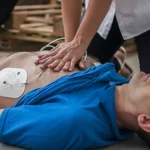The term arrest can be used to describe a failure of the blood circulatory system or the heart. Respiratory failure or Cardiac arrest can be life threatening and can lead to respiratory distress. There is a wide difference between cardiac arrest and respiratory arrest. Sometimes the respiratory arrest is termed as a pulmonary arrest. Many times, this causes more confusion. This is mostly used when referring to first aid and CPR certification online as a treatment for cardiopulmonary arrest.
Difference between Cardiac and Pulmonary Arrest
The difference between cardiac arrest and respiratory arrest can simply be brought about by a pulse. Normal breathing is affected during a respiratory or pulmonary arrest. While in a cardiac arrest the normal flow of blood in parts of the body stops and the oxygen levels start to drop. Cardiac arrest is the state where the heart stops beating since blood flow is less detected. Although, the heart might still be trying to pump blood to other body parts.
How to Differentiate?
Feeling the pulse is not the perfect method for determining a heartbeat, but it helps where proper equipment is unavailable. Rescuers often spend more time checking for a pulse when the victim does not show signs of one. CPR guidelines recommend treating cardiac arrest and respiratory arrest similarly. Call emergency helplines and begin chest compressions and rescue breaths.
Feeling the pulse is not the perfect method for determining a heartbeat but it helps where proper equipment is unavailable. Many times, rescuers spend more time checking for a pulse when the victim does not show signs of one. According to CPR training, a cardiac arrest and a respiratory arrest should be treated the same way. Call emergency helplines, and begin chest compressions and rescue breaths.
Respiratory Arrest Causes Cardiac Arrest
The two conditions are linked as respiratory arrest will definitely lead to a cardiac arrest if there is no one to treat it. When a person has a respiratory arrest-
- Carbon dioxide in the bloodstream is not fully removed hence causing a pileup of carbonic acid. The carbonic acid in excess affects the heart, the brain and other vital organs.
- With the piling up of carbon dioxide in the bloodstream, the level of oxygen consequently goes down. Insufficient oxygen in the blood leads to heart and brain problems.
Without necessary treatment and care, respiratory arrest leads to cardiac arrest.
Cardiac Arrest in Brief
Cardiac arrest is when the heart is not pumping blood to other vital organs. During a cardiac arrest, the heart might either be beating or not beating. But in both circumstances, blood is not moving to body parts. The brain cannot function without a sufficient supply of blood. To keep the brain cells alive, a constant supply of blood rich in oxygen is required. The brain shuts as soon as the blood supply stops. Rescuers should have first aid and CPR certification online in order to provide effective help during an emergency.
Register today to learn CPR skills today with the American HealthCare Academy.













